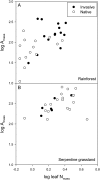The physiology of invasive plants in low-resource environments
- PMID: 27293610
- PMCID: PMC4806624
- DOI: 10.1093/conphys/cot026
The physiology of invasive plants in low-resource environments
Abstract
While invasive plant species primarily occur in disturbed, high-resource environments, many species have invaded ecosystems characterized by low nutrient, water, and light availability. Species adapted to low-resource systems often display traits associated with resource conservation, such as slow growth, high tissue longevity, and resource-use efficiency. This contrasts with our general understanding of invasive species physiology derived primarily from studies in high-resource environments. These studies suggest that invasive species succeed through high resource acquisition. This review examines physiological and morphological traits of native and invasive species in low-resource environments. Existing data support the idea that species invading low-resource environments possess traits associated with resource acquisition, resource conservation or both. Disturbance and climate change are affecting resource availability in many ecosystems, and understanding physiological differences between native and invasive species may suggest ways to restore invaded ecosystems.
Keywords: Invasion biology; leaf economics spectrum; resource acquisition; resource conservation; restoration ecology.
Figures




References
-
- Aanderud ZT, Bledsoe CS. (2009) Preferences for 15N-ammonium, 15N-nitrate, and 15N-glycine differ among dominant exotic and subordinate native grasses from a California oak woodland. Environ Exp Bot 65: 205–209.
-
- Aarssen LW. (1983) Ecological combining ability and competitive combining ability in plants: toward a general evolutionary theory of coexistence in systems of competition. Am Nat 122: 707–731.
-
- Ackerly DD, Bazzaz FA. (1995) Leaf dynamics, self-shading and carbon gain in seedlings of a tropical pioneer tree. Oecologia 101: 289–298. - PubMed
-
- Alpert P, Bone E, Holzapfel C. (2000) Invasiveness, invasibility and the role of environmental stress in the spread of non-native plants. Perspect Plant Ecol Evol Syst 3: 52–66.
-
- Angert AL, Huxman TE, Barron-Gafford GA, Gerst KL, Venable DL. (2007) Linking growth strategies to long-term population dynamics in a guild of desert annuals. J Ecol 95: 321–331.
Publication types
LinkOut - more resources
Full Text Sources
Other Literature Sources

